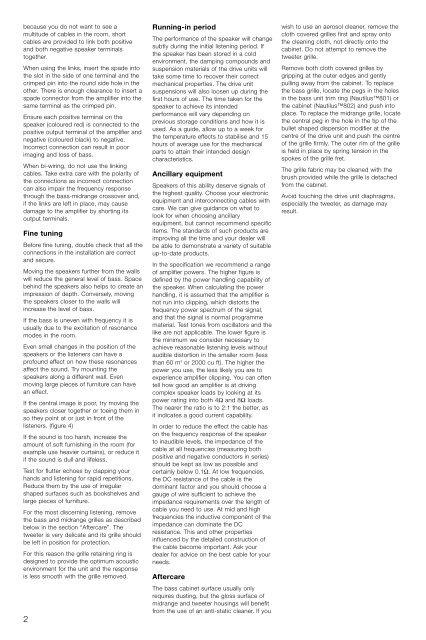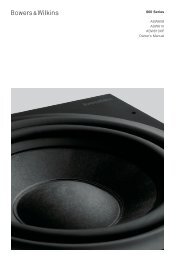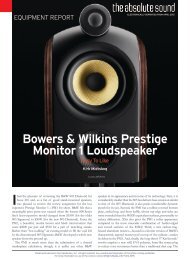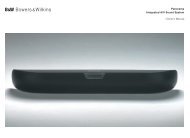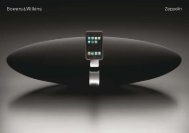NautilusTM801 NautilusTM802 Owner's Manual ... - Bowers & Wilkins
NautilusTM801 NautilusTM802 Owner's Manual ... - Bowers & Wilkins
NautilusTM801 NautilusTM802 Owner's Manual ... - Bowers & Wilkins
You also want an ePaper? Increase the reach of your titles
YUMPU automatically turns print PDFs into web optimized ePapers that Google loves.
ecause you do not want to see a Running-in period<br />
multitude of cables in the room, short<br />
cables are provided to link both positive<br />
and both negative speaker terminals<br />
together.<br />
The performance of the speaker will change<br />
subtly during the initial listening period. If<br />
the speaker has been stored in a cold<br />
environment, the damping compounds and<br />
When using the links, insert the spade into suspension materials of the drive units will<br />
the slot in the side of one terminal and the take some time to recover their correct<br />
crimped pin into the round side hole in the mechanical properties. The drive unit<br />
other. There is enough clearance to insert a suspensions will also loosen up during the<br />
spade connector from the amplifier into the first hours of use. The time taken for the<br />
same terminal as the crimped pin.<br />
speaker to achieve its intended<br />
Ensure each positive terminal on the<br />
speaker (coloured red) is connected to the<br />
positive output terminal of the amplifier and<br />
negative (coloured black) to negative.<br />
Incorrect connection can result in poor<br />
imaging and loss of bass.<br />
When bi-wiring, do not use the linking<br />
performance will vary depending on<br />
previous storage conditions and how it is<br />
used. As a guide, allow up to a week for<br />
the temperature effects to stabilise and 15<br />
hours of average use for the mechanical<br />
parts to attain their intended design<br />
characteristics.<br />
cables. Take extra care with the polarity of Ancillary equipment<br />
the connections as incorrect connection<br />
can also impair the frequency response<br />
through the bass-midrange crossover and,<br />
if the links are left in place, may cause<br />
damage to the amplifier by shorting its<br />
output terminals.<br />
Speakers of this ability deserve signals of<br />
the highest quality. Choose your electronic<br />
equipment and interconnecting cables with<br />
care. We can give guidance on what to<br />
look for when choosing ancillary<br />
equipment, but cannot recommend specific<br />
Fine tuning<br />
items. The standards of such products are<br />
improving all the time and your dealer will<br />
Before fine tuning, double check that all the be able to demonstrate a variety of suitable<br />
connections in the installation are correct up-to-date products.<br />
and secure.<br />
In the specification we recommend a range<br />
Moving the speakers further from the walls of amplifier powers. The higher figure is<br />
will reduce the general level of bass. Space defined by the power handling capability of<br />
behind the speakers also helps to create an the speaker. When calculating the power<br />
impression of depth. Conversely, moving handling, it is assumed that the amplifier is<br />
the speakers closer to the walls will<br />
not run into clipping, which distorts the<br />
increase the level of bass.<br />
frequency power spectrum of the signal,<br />
If the bass is uneven with frequency it is<br />
usually due to the excitation of resonance<br />
modes in the room.<br />
and that the signal is normal programme<br />
material. Test tones from oscillators and the<br />
like are not applicable. The lower figure is<br />
the minimum we consider necessary to<br />
Even small changes in the position of the achieve reasonable listening levels without<br />
speakers or the listeners can have a<br />
audible distortion in the smaller room (less<br />
profound effect on how these resonances than 60 m<br />
affect the sound. Try mounting the<br />
speakers along a different wall. Even<br />
moving large pieces of furniture can have<br />
an effect.<br />
If the central image is poor, try moving the<br />
speakers closer together or toeing them in<br />
so they point at or just in front of the<br />
listeners. (figure 4)<br />
If the sound is too harsh, increase the<br />
amount of soft furnishing in the room (for<br />
example use heavier curtains), or reduce it<br />
if the sound is dull and lifeless.<br />
Test for flutter echoes by clapping your<br />
hands and listening for rapid repetitions.<br />
Reduce them by the use of irregular<br />
shaped surfaces such as bookshelves and<br />
large pieces of furniture.<br />
For the most discerning listening, remove<br />
the bass and midrange grilles as described<br />
below in the section “Aftercare”. The<br />
tweeter is very delicate and its grille should<br />
be left in position for protection.<br />
For this reason the grille retaining ring is<br />
designed to provide the optimum acoustic<br />
environment for the unit and the response<br />
is less smooth with the grille removed.<br />
3 or 2000 cu ft). The higher the<br />
power you use, the less likely you are to<br />
experience amplifier clipping. You can often<br />
tell how good an amplifier is at driving<br />
complex speaker loads by looking at its<br />
power rating into both 4Ω and 8Ω loads.<br />
The nearer the ratio is to 2:1 the better, as<br />
it indicates a good current capability.<br />
In order to reduce the effect the cable has<br />
on the frequency response of the speaker<br />
to inaudible levels, the impedance of the<br />
cable at all frequencies (measuring both<br />
positive and negative conductors in series)<br />
should be kept as low as possible and<br />
certainly below 0.1Ω. At low frequencies,<br />
the DC resistance of the cable is the<br />
dominant factor and you should choose a<br />
gauge of wire sufficient to achieve the<br />
impedance requirements over the length of<br />
cable you need to use. At mid and high<br />
frequencies the inductive component of the<br />
impedance can dominate the DC<br />
resistance. This and other properties<br />
influenced by the detailed construction of<br />
the cable become important. Ask your<br />
dealer for advice on the best cable for your<br />
needs.<br />
2<br />
Aftercare<br />
The bass cabinet surface usually only<br />
requires dusting, but the gloss surface of<br />
midrange and tweeter housings will benefit<br />
from the use of an anti-static cleaner. If you<br />
wish to use an aerosol cleaner, remove the<br />
cloth covered grilles first and spray onto<br />
the cleaning cloth, not directly onto the<br />
cabinet. Do not attempt to remove the<br />
tweeter grille.<br />
Remove both cloth covered grilles by<br />
gripping at the outer edges and gently<br />
pulling away from the cabinet. To replace<br />
the bass grille, locate the pegs in the holes<br />
in the bass unit trim ring (Nautilus801) or<br />
the cabinet (Nautilus802) and push into<br />
place. To replace the midrange grille, locate<br />
the central peg in the hole in the tip of the<br />
bullet shaped dispersion modifier at the<br />
centre of the drive unit and push the centre<br />
of the grille firmly. The outer rim of the grille<br />
is held in place by spring tension in the<br />
spokes of the grille fret.<br />
The grille fabric may be cleaned with the<br />
brush provided while the grille is detached<br />
from the cabinet.<br />
Avoid touching the drive unit diaphragms,<br />
especially the tweeter, as damage may<br />
result.


